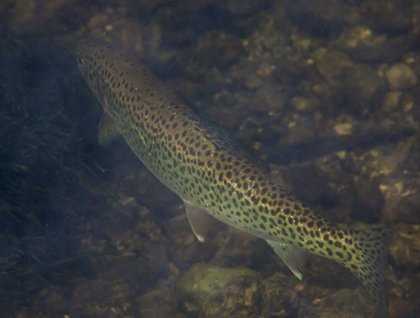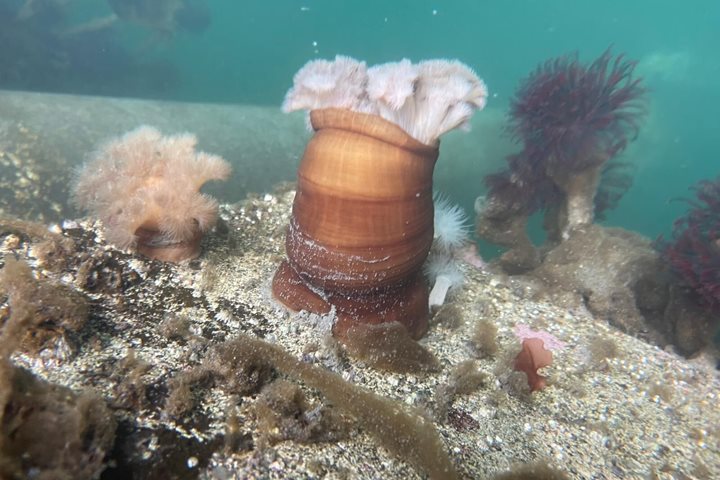Cooler weather and a humpback whale outside the dining room window at breakfast greeted our last full day exploring the beautiful and vast wilderness of Southeast Alaska as we slowly cruised in Hood Bay on Admiralty Island.
Admiralty Island merits the distinction of possessing the densest concentration of coastal brown bears (grizzly bears) in North America. Although we diligently searched shorelines and salt marshes for this elusive and magnificent bear, the few promising possibilities sadly turned out to be appropriately shaped rocks or stumps. Grizzly bears perhaps symbolize and are synonymous with wilderness more than any other critter. They don’t and can’t exist where humans and their assorted trappings exist! We have enjoyed the incredible good fortune to observe brown bears in their natural habitat in this relatively untouched wilderness of Southeast Alaska nearly devoid of human encroachment.
Mid-morning brought yet another opportunity to marvel at the elegance and grace of the magnificent humpback whales we have had the good fortune to observe every day of our cruise. Humpback whale behavior is indeed complex and although we have been intensely studying them for over 30 years there is still much we don’t know. The answer to several questions this week regarding the whale behaviors we have seen has necessarily been. “We don’t really know.” Perhaps Birgit’s National Geographic Crittercam has the potential to revolutionize our research methods and possibly reveal some long sought after answers.
The native first nations people of the Pacific Northwest Coast thrived in a complex society rich in art, culture, and tradition for more than 8,000 years prior to European contact. Russia would be the first European power in the “Age of Exploration” to explore, then claim, occupy, and establish fur hunting outposts in Alaska. Their sphere extended along the Pacific Northwest Coast as far south as northern California for over 125 years before continual land claim disputes with Great Britain and Spain and the diminishment of fur trade revenue promulgated the sale of Alaska to the United States in 1867. William enthusiastically detailed the fascinating history of the Russian era in Alaska, an extremely significant but not well known segment of United States history only peripherally taught in school history classes. Sitka, the charming small town final destination of our cruise and once known as the “Paris of the Pacific” served for nearly 70 years as the capital and administrative headquarters of Russian America.
The Pacific coastal marine rain forest stretching along the Pacific Northwest outer coast from Northern California to the Yakataga coastline just north of Glacier Bay constitutes the largest temperate rain forest in the world. We have investigated several stages of the primary succession sequence of this unique forest from the infancy of scattered alder thickets sprouted shortly after receding glacier ice frees the land (Endicott Arm) to the monocultures of a 50-year-old spruce forest (George Island) to the maturing but still emerging mixed spruce and hemlock forest (Bartlett Cove) to the magnificent old growth hemlock dominated forest of Pavlof Harbor and today, Lake Eva. Our hikes today would be our last foray into this unique, lovely, and lush rain forest!
Captain Cook introduced the whole crew this evening at the Farewell Gala Dinner to a rousing round of applause following our final naturalist Recap presentations. Tonight, we pack our belongings, memories of a most magnificent and wonderful week together meeting new friends, exploring new country, and learning new and exciting things. Alaska is a place that does not give itself up easily. It remains in the face of modern America a vast, mostly inaccessible, weather-beaten landscape both difficult and expensive to explore. Most of the million plus visitors to Alaska each year “see” Alaska through the windows or decks of cruise ship, window of a bus or train car—we “experienced” Alaska; felt the bite of cold, sting of rain, smelled the fecundity of the deep forest and breathed the freshness of its mountain air. The National Geographic Sea Bird is the perfect platform to discover this most spectacular and awesome chunk of country and the staff and crew have thoroughly enjoyed the privilege of showing you this beautiful place called Alaska!







